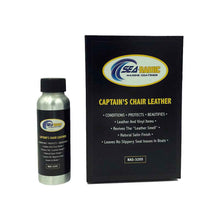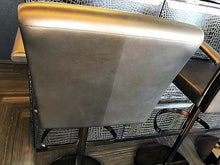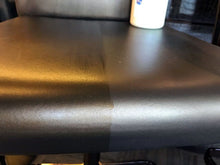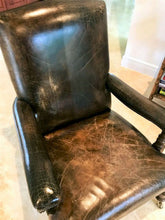-
Helps to prevent UV damage.
-
Does not leave the surface greasy, slick, or glossy.
-
Has a nice natural leather fragrance.
-
Great for any leather and all vinyl seating or surfaces.
-
If used for exterior applications, allow 12 hours prior to getting wet.
-
Approximate coverage: Dependent on the condition of the leather or vinyl.
Application Guide
NAS-3205 Captain’s Chair Leather
“Natural Soft and luxurious Supple Feel”
NAS-3205 was Created to Condition • Protect • Beautify • Leather and Vinyl items
- Revives the “Leather Smell” • No slick or greasy feel • Natural Satin Finish
- Leaves no slippery seat issues in cars, trucks, motorcycles, boats or planes
- Use on • Golf Bags • Belts • Holsters • Horse Harnesses • Saddles • Boots • Bags • Luggage
The NAS-3205 Captain’s Chair Leather cleans as it is applied:
⦁ Application is best by a soft terry-cloth towel, apply a modest amount on to the cloth, then with a circular motion and moderate pressure work the NAS-3205 into the surface, as it is absorbed into the surface, it will continue to soften and protect the surface from the elements and UV damage.
⦁ Let this application absorb into the surface, after a short time, if there is more product on an area that will absorb into the surface, just re-wipe spreading the excess over a larger area, or simply wipe off any excess.
⦁ On older leather surfaces that may have become somewhat hardened; apply a liberal amount onto the surface – though it may best to continue with a second or third application, letting each application soak in and penetrate into the fibers allowing them to become more flexible.
⦁ On older vinyl surfaces, automotive dashes, etc. that have become somewhat hardened, (not cracked*), the same would apply; apply a liberal amount onto the surface – though it may best to continue with a second or third application, letting each application soak in and penetrate into the fibers allowing them to become more flexible.
⦁ *NAS-3205 Captain’s Chair Leather will not repair any cracks in leather or vinyl, though it will soften the area around them, helping to prevent further cracking.
⦁ NAS-3205 may not always remove all stubborn or chemical stains
Material Safety Data Sheet
SECTION 1 – PRODUCT INFORMATION
Supplier:
Nasco World Wide LLC
1281 North Ocean Drive
Singer Island, FL 33404
Emergency Number:
Chem Tel 800-255-3924
IMPORTANT: BEFORE USING ANY MATERIALS,
HAVE ALL PROCESSING PERSONNEL READ THIS DOCUMENT!
SECTION 2 – COMPOSITION/INFORMATION ON INGREDIENTS
CAS No: Chemical name Percentage value
9011-19-2 Poly octa-siloxane 05-15%
5989-27-5 D- Limonene (citrus oil) 15-25%
Balance of ingredients are deemed non-hazardous
SECTION 3 – HAZARDS IDENTIFICATION
HMIS RATINGS
Health Hazard: 1 Slight
Flammability Hazard 0 Least
Reactivity Hazard: 0 Least
POTENTIAL HEALTH EFFECTS
Routes of Entry:
Eyes, Ingestion, Inhalation, Skin.
Target Organs:
Central Nervous System, Kidneys, Liver.
Irritancy:
Eyes, Respiratory Tract, Skin.
Sensitizing Capability:
None Known.
Reproductive Effects:
None Known.
Cancer Information:
Not known to be carcinogenic.
SHORT-TERM EXPOSURE (ACUTE)
Inhalation:
May cause irritation
Eyes: May be irritating.
Skin:
May cause irritation or slight dermatitis
Ingestion:
If swallowed, DO NOT induce vomiting. Consult medical attention immediately.
REPEATED EXPOSURE (CHRONIC)
Prolonged or repeated breathing or swallowing of large amounts may cause discomfort.
Synergistic Materials:
None Known.
Medical Conditions Aggravated by Exposure:
None Known.
SECTION 4 – FIRST AID MEASURES
Eye Exposure:
Immediately flush with water for at least 15 minutes. If irritation persists, seek medical attention.
Dermal Exposure:
Wash thoroughly with soap and water. Wash clothing before re-use. If irritation persists, seek medical attention.
Inhalation Exposure:
Remove to fresh air. If breathing is difficult, have trained person administer oxygen. If breathing stops, have trained person administer artificial respiration and seek medical attention immediately.
Oral Exposure:
Do not induce vomiting. Seek medical attention immediately.
SECTION 5 – FIRE FIGHTING MEASURES
Extinguishing Media:
Carbon dioxide, dry chemical powder, or appropriate foam.
Fire Fighting Procedures:
Wear self-contained breathing apparatus and full protective clothing.
Fire and Explosion Hazard:
May emit toxic fumes under fire conditions.
Sensitivity to Mechanical Impact:
Not applicable.
Sensitivity to Static Charge:
NA.
SECTION 6 – ACCIDENTAL RELEASE MEASURES
Personal Precautions:
No precautions.
Environmental Precautions:
Contain liquids and prevent discharge into streams and sewers, control or stop the loss of volatile material to the atmosphere. Do not apply water to the spill. Spills should be reported, if required, to the appropriate local, state, and federal agencies.
Small Spills:
Cover with an inorganic absorbent, such as vermiculite, perlite, ground clay, or sand; sweep up, and dispose of appropriately.
Large Spills:
Dike to contain and pump into drums for disposal. Add inorganic absorbent to remaining material (as above), sweep up, and dispose of appropriately. Clean contaminated area with soap and water.
In case of accidental spill or release, refer to Section 8, Personal Protective Equipment and General Hygiene Practices.
SECTION 7 – HANDLING AND STORAGE
Handling:
Avoid breathing vapors, use adequate ventilation.
Avoid eye contact.
Wear personal protective equipment as described in Section 8, Personal Protective Equipment and General Hygiene Practices.
Wash thoroughly with soap and water after handling.
Avoid sparks, pilot lights, welding operations, and open flame.
Do not reuse containers.
Storage:
Keep container properly closed and properly labeled.
Store in a cool place designated for flammable liquid storage.
Keep away from heat, sparks, and open flame.
Vent periodically to release head pressure.
SECTION 8 – EXPOSURE CONTROLS/PERSONAL PROTECTION
Appropriate Hygienic Practices:
Avoid contact with eyes, skin, and clothing. Avoid breathing vapors, fumes, and mists. Avoid prolonged or repeated exposure. Wash thoroughly after handling, and before eating, drinking, or smoking.
Engineering Controls:
General room ventilation plus local exhaust at points of emission to maintain levels of airborne contaminates below exposure limits.
Respiratory:
If mists or aerosols are generated during handling, wear a respirator equipped with an organic vapor cartridge.
Eye/Face:
Wear safety goggles plus a full-face shield to protect against splashing when appropriate.
Skin:
Wear plastic or rubber apron for splash protection. Wear chemical resistant gloves.
Other:
Emergency shower and eyewash facility should be in close proximity.
SECTION 9 – PHYSICAL AND CHEMICAL PROPERTIES
Appearance and Odor: Liquid, various colors. naphthalenic odor.
VOC (grams / liters): <5%
Freezing Point: -50F
Viscosity: 20-25 seconds (# 2 Zahn Cup)
Flash Point: 194F
Boiling Point: >390F
SECTION 10 – STABILITY AND REACTIVITY
Chemical Stability: Stable
Reacts with: Strong oxidizing agents, strong acids or bases of selected amines..
Hazardous Polymerization: Will not occur.
Hazardous Decomposition Products: Carbon Monoxide, Carbon Dioxide.
SECTION 11 – TOXICOLOGICAL INFORMATION
Carcinogenicity Information:
Not listed as carcinogen by NTP (National Toxicology Program); not regulated as a carcinogen by OSHA (Occupational Safety and Health Administration); not evaluated by IARC (International Agency for Research on Cancer).
Reported Human Effects:
No human studies have been conducted with this material. The use of recommended protective equipment should prevent any adverse effects.
SECTION 12 – ECOLOGICAL INFORMATION
This material may be hazardous to aquatic organisms. Avoid release to surface waters and waste treatment systems.
SECTION 13 – DISPOSAL CONSIDERATIONS
Do not mix this product with aqueous or other protic wastes streams. Incineration of combustible waste material in a permitted facility in accordance with the local, state, and federal regulations is the recommended disposal method.
SECTION 14 – TRANSPORTATION INFORMATION
US DOT:
Proper Shipping Name:
Natural Polymers emulsions
Not regulated
IATA:
Proper Shipping Name: Natural Polymers emulsions
Not regulated
SECTION 15 – REGULATORY INFORMATION
U.S. Federal Regulations:
OSHA Standard 29 CFR 1910.1200 requires that information be provided to employees regarding the hazards of chemicals by means of hazard communication program including labeling, material safety data sheets, training and access to written records. We request that you, and it is your legal duty to, make all information in this Material Safety Data Sheet available to all your employees.
Technical Data Sheet
NAS-3205 CAPTAIN’S CHAIR LEATHER
(Ideal for use on all Leather and Vinyl)
NAS-3205 Captain’s Chair Leather is unequaled for Ease of Application & Quality
NAS-3205 Brings Great UV resistance Restores the “Rich Luster” of Leather and Vinyl
NAS-3205applies easily by hand Can be used in direct sun light Cleans as it is applied
NAS-3205Treatment is approved, safe for use in & around USA water ways (if used as directed)
NAS-3205 Captain’s Chair Leather leaves a natural look without being slippery or greasy
“When Only the Best Will Do”
Cleans & Protects • Applies in Direct Sunlight • Provides a Rich Luster
NAS-3205 Captain’s Chair Leather Properties:
⦁ Color Beige
⦁ Viscosity Thick Liquid
⦁ Odor (liquid) Leather
⦁ V.O.C. None
⦁ Halogens None
⦁ RoHS Compliant
⦁ REACH Compliant








